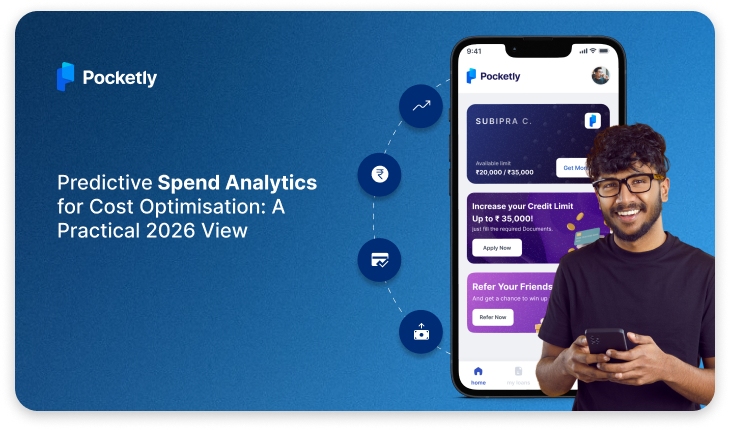
Have you ever noticed your loan rates creeping up just when you need cash the most? It’s frustrating, and the MSF Rate might be the quiet culprit. If you’re a student juggling college fees, a salaried pro stretching your salary, or an entrepreneur tackling unpredictable expenses, this rate can hit your wallet without you even realising it.
When the MSF Rate rises, banks often pass on the higher costs to borrowers, leading to increased loan rates for you. This means that the cost of borrowing becomes more expensive, especially during financial crunches.
The Marginal Standing Facility (MSF) Rate is the RBI’s emergency fix for banks, and it ripples straight to your loan costs. In this blog, you’ll discover what the MSF Rate means, how it works, and why it matters to your finances. Let’s get into it!
What Does MSF Rate Mean?
The MSF Rate, or Marginal Standing Facility Rate, is a special interest rate set by the Reserve Bank of India (RBI). It comes into play when banks need cash quickly and can't borrow from other sources. Think of it as an emergency loan that the RBI provides to banks overnight to keep things running smoothly.
This rate is a bit higher than regular loan rates. It’s usually set 0.25% (or 25 basis points) above the repo rate, which is currently at 6.50%.
So, why does it exist? The RBI uses the MSF Rate to maintain stability in the banking system. When banks run low on funds and can’t borrow from other places, the MSF ensures there's enough liquidity to keep everything functioning properly.
But here’s the important part: While you won’t deal with the MSF Rate directly, it still affects you. Only banks can use this rate, and they have to offer government-backed securities to access these funds. However, since the MSF Rate influences the overall interest rates in the market, it can lead to higher loan costs for you.
Now that you understand what the MSF Rate is and why it matters, let’s break down a few key terms related to it.
Key Important Terms Related to MSF
Here are 5 frequently used terms in relation to the MSF, each explained as follows:
- NTDL - Net Time and Demand Liabilities
- NTDL is a combination of two types of liabilities that a bank or NBFC holds towards its customers: Time Liabilities and Demand Liabilities. Demand liabilities are payable on demand, while time liabilities are those that are paid after a certain period.
- SLR - Statutory Liquidity Ratio
- SLR refers to the liquid assets that commercial banks in India must maintain in the form of government-approved securities, gold, or liquid cash. These reserves ensure that banks can meet their short-term obligations and are calculated as a percentage of their total demand and time liabilities.
- Repo Rate
- The Repo Rate is the interest rate at which the RBI lends money to commercial banks. During inflationary periods, the RBI raises the repo rate to make borrowing more expensive and reduce spending. When the economy needs a boost, the RBI lowers the rate to make borrowing cheaper.
- Reverse Repo Rate
- When banks have surplus funds, they can lend that money to the RBI at the Reverse Repo Rate. This rate, set by the RBI, helps manage liquidity and ensures that banks have an incentive to park surplus funds with the RBI rather than keep them idle.
- Bank Rate
- The Bank Rate is the rate at which the RBI offers long-term loans to banks and NBFCs. Unlike the Repo Rate, which applies to short-term loans, the Bank Rate is used for lending over a longer period.
Now that you’re familiar with the key terms related to MSF, it's important to understand how these financial systems work together to keep the economy stable. For better understanding, check out our article on Understanding the Process and Meaning of Credit Control, which explains how effective credit control plays a role in ensuring financial stability.
Understanding how the MSF Rate works is key to grasping its influence on your finances. Let’s understand how the MSF Rate actually works.
How Does the MSF Rate Work?
Now that you understand the MSF Rate meaning, how does it function in practice? It’s a quick solution that the Reserve Bank of India (RBI) provides when banks face a cash shortage. Banks act as financial hubs. When they lend too much or customers withdraw large amounts, they can run low on funds. If borrowing from other banks isn’t an option, the RBI offers money at the Marginal Standing Facility Rate, currently 6.50%. This rate sits slightly higher than the repo rate (6.25%), making it a backup choice for banks in need.
The process is simple. Banks provide their government securities, known as Statutory Liquidity Ratio (SLR) assets, to the RBI. These are reserves they already hold. The RBI then supplies cash, limited to 2% of the bank’s total deposits. This loan happens overnight, and banks repay it the next day with added interest. This support keeps the banking system stable.
Want a simple breakdown? Here’s the flow:
Bank runs low on cash
↓
Offers SLR securities to RBI
↓
RBI lends money at 6.50%
↓
The bank repays the next day with interest.
Let’s understand this by an example -
A bank needs ₹100 crore because a major customer withdrew funds late in the day. It contacts the RBI after 5 PM, provides its SLR securities, and receives the cash at 6.50%. The next morning, it returns ₹100.17 crore, covering the loan and a small interest amount. That extra cost can slightly increase the loan rates you encounter later.
Now you’ve seen how the MSF Rate operates, let’s compare it to other rates you might come across.
MSF Rate vs. Other Rates: What’s the Difference?
The Reserve Bank of India (RBI) uses a handful of rates to keep money moving in the economy, and each one impacts your loans in its own way. To help you get the full picture, let’s compare the MSF Rate with the Repo Rate and Reverse Repo Rate across a few key points.
Here’s a table breaking it all down:
| Rate | Value (March 25, 2025) | Purpose | Duration | Who Uses It | What It Means |
|---|---|---|---|---|---|
| MSF Rate | 6.50% | Emergency cash for banks in a tight spot | Overnight only | Scheduled commercial banks | The rate banks pay to borrow from the RBI using SLR securities. It’s higher since it’s a backup when options run out. |
| Repo Rate | 6.25% | Regular borrowing to manage daily needs | Short to medium term | Scheduled commercial banks | The rate banks pay to borrow from the RBI. It’s cheaper and keeps everyday lending flowing smoothly. |
| Reverse Repo Rate | 6.00% | Parking excess cash to control money supply | Overnight or short-term | Scheduled commercial banks | The rate the RBI pays banks to deposit extra cash. It’s the lowest, helping manage extra money in the system. |
What stands out? The MSF Rate is your bank’s lifeline during a cash crunch, but it’s short and costly. The Repo Rate keeps things steady day-to-day with a lower rate, while the Reverse Repo Rate pulls money back when there’s too much floating around. These differences shape the interest you pay on loans, so knowing them helps you see why borrowing costs might change.
Now you’ve got a solid grip on these rates, let’s explore how the MSF Rate hits your finances.
How MSF Rate Impacts You
The MSF Rate isn’t just something that banks deal with, it also has a direct impact on your finances. Set at 6.50%, the Marginal Standing Facility Rate plays a role in determining the interest rates you pay. Whether you're a student managing college expenses, a salaried person juggling bills, or an entrepreneur running a business, the MSF Rate influences your financial costs. Let’s break down how this rate affects you:
1. Higher Loan Costs
When banks borrow from the RBI at 6.50% in a cash pinch, it’s more expensive than the repo rate (6.25%). They pass this cost to you by raising interest rates on loans. That means your monthly EMI for a bike or personal loan creeps up. It’s a small shift, but you’ll feel it in your budget over time.
2. Tighter Money Supply
The RBI uses the MSF Rate to keep cash in check during rough patches. This limits how much money banks have to lend out. You might face delays getting a loan approved, especially if you need it fast. For students or self-employed folks, that wait can throw off your plans.
3. Credit Crunch for You
If banks turn to the MSF Rate too often, they tighten their lending rules to stay safe. This hits harder if you’re a student with no credit history yet or an entrepreneur with up-and-down earnings. Getting approved for a loan might take extra effort. It could even mean missing out on quick cash when you need it most.
4. Everyday Expenses
Your daily costs take a hit as loan rates rise with the MSF Rate. That emergency cash for a broken phone or a bill payment starts costing more. You might have to stretch your salary further or dip into savings. It’s not just big loans; even small borrowing feels heavier.
5. Opportunity Costs
With loans pricier due to the MSF Rate, you might rethink big steps. A student could skip a new laptop for college work because the loan feels too steep. An entrepreneur might delay a business idea, waiting for better rates. It’s a quiet way this rate limits what you can do.
This rate does more than tweak bank numbers. It changes how you borrow, spend, and plan, especially when money’s tight.
Did You Know?
The MSF Rate isn’t just a random tool. It kicked off in May 2011 as part of the Reserve Bank of India’s plan to give banks a safety net during unexpected cash shortages. Picture this: it’s like an after-hours ATM for banks, open from 5 PM to 9 AM when regular borrowing windows close. This helps them handle late-day surprises, like a big withdrawal or a sudden payment demand. Back then, the RBI set it at 100 basis points above the repo rate. Today, it’s a tighter 25 basis points, sitting at 6.50%. Pretty handy for keeping the banking world steady!
Seeing how the MSF Rate affects you, let’s discover how Pocketly’s loans can lighten the load.
Why Pocketly’s Loans Are Your Smart Solution
Seeing how the MSF Rate affects you, especially with higher loan costs and tighter cash, you might wonder how to stay ahead. That’s where Pocketly comes in with a clever fix. This digital lending platform is built for young Indians like you, whether you’re a student needing quick cash for college, a salaried pro covering bills, or an entrepreneur sorting unexpected expenses. When the MSF Rate pushes traditional loan rates up, Pocketly offers a way to sidestep the stress. Here’s why it’s your go-to:
- Fast Cash When You Need It: Pocketly gives you loans from ₹1,000 to ₹25,000 in a snap. No waiting around for days like with banks, slowed by MSF Rate ripples. You apply, get approved, and see funds in your account often within hours. It’s perfect for those sudden costs that can’t wait.
- Simple and Easy Process: Forget piles of paperwork or long queues. Pocketly’s app is user-friendly and lets you apply with just basic KYC details, like your Aadhaar or PAN. It’s all digital, so you can handle it from your phone anytime, anywhere. No fuss, just results.
- Clear Costs, No Surprises: Loans start at a 2% monthly interest rate with a processing fee of 1-8%. You’ll know exactly what you’re paying upfront, unlike some bank loans that hide extra charges. Pocketly keeps it transparent so that you can plan your budget with confidence.
- Flexible Repayment Options: You pick how to pay back, with EMI choices that fit your cash flow. Need to settle early? No problem, there’s no penalty. This flexibility helps you manage money without feeling trapped, even when rates rise.
- Built for Your Life: Whether it’s ₹5,000 for a laptop repair or ₹20,000 for a business need, Pocketly tailors loans to you. It’s there for students, salaried folks, and self-employed between 18 and 40, offering a lifeline when traditional borrowing gets tough.
Struggling with a cash crunch? Explore Pocketly to see how it works for you. It’s a smart way to keep your finances on track, no matter what the MSF Rate throws your way.
Ready to grab a Pocketly loan? Let’s walk through how to apply in a few easy steps.
How to Apply for a Personal Loan via Pocketly
With just minimal yet simple steps, you can get the funds you need without the delays.
- Download and Sign Up:
- Start by downloading the Pocketly app from the App Store or Play Store. Create an account using your mobile number—it’s fast, secure, and user-friendly.
- Upload Your Documents:
- No more dealing with endless paperwork. Simply upload your KYC documents through the app, it’s quick, secure, and straightforward, taking only a few minutes.
- Select Your Loan Amount:
- Choose an amount that suits your needs, whether it’s a smaller sum of ₹1,000 or something larger, like ₹25,000. Pocketly ensures flexibility to cater to your requirements.
- Quick Approval:
- Once your application is submitted, Pocketly’s system reviews it instantly. Most loans are approved within minutes, eliminating the usual waiting period.
- Receive Funds Immediately:
- Once approved, the loan amount is credited directly to your bank account. This swift process ensures that you have the money exactly when you need it.
Pocketly offers fast approvals, minimal paperwork, and flexible repayments to suit your needs. Download the Pocketly app now and borrow with confidence!
Conclusion
The MSF Rate, set at 6.50%, isn’t just a bank thing. It can make your loans cost more and slow down your cash, whether you’re a student, salaried person, or entrepreneur. Higher interest rates and delays in getting loans can mix up your plans. But you don’t have to worry. Pocketly brings you fast, easy loans from ₹1,000 to ₹25,000 that fit your life. With a simple app, clear fees starting at 2% monthly interest, and quick approvals, it’s there to help you out. You can fix emergencies or grab opportunities without sweat. It’s all about keeping your money stuff simple.
Don’t let higher rates trip you up. Get the Pocketly app now. Download for Android or Download for iOS, and stay ready for anything the MSF Rate throws your way.
FAQs
- How fast can I get a loan from Pocketly?
- You can get cash in your account in as little as an hour if you’re non-salaried, or within a day if you’re salaried, as long as your details check out. It’s way quicker than banks, which take days. Perfect for when you’re in a pinch and need money now.
- Is Pocketly safe to use?
- Yep, it’s legit. Pocketly partners with Speel Finance, an RBI-registered NBFC, and uses 128-bit SSL encryption to keep your info secure. No shady stuff here—just a trusted app for young Indians like you.
- What’s the catch with these low loan amounts?
- No catch. Loans start at ₹1,000 and go up to ₹25,000 (or ₹50,000 for some) to fit small, urgent needs. Interest is 2-3% monthly, and fees are clear upfront (1-8%). It’s about flexibility, not trapping you.
- Can I get a loan if I don’t have a job?
- Totally. If you’re over 18 with some income, like freelancing or pocket money—you can apply. Non-salaried folks get a starter loan to kick off their credit journey. Just show your Aadhaar and PAN.
- What happens if I miss a payment?
- You’ll face a daily penalty based on your loan size, added until you pay up. Pocketly won’t bug your contacts unless it’s serious, but it’s best to chat with support if you’re stuck—they’re there 24/7.
- Why choose Pocketly over a bank?
- Banks drag approvals out for days and drown you in paperwork. Pocketly’s all online, needs minimal docs, and moves fast. Plus, it’s open 24/7, so you’re not stuck waiting for branch hours.
















